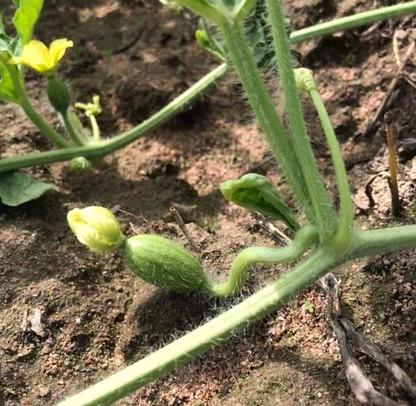











● Watermelon has a large and shallow root system
● Needs sufficient water, but is sensitive for water lodging
● The plants are more sensitive than other crops to lack of nitrogen
● In the initial fruit stage, prevent lack of water (will reduce yields and affect fruit quality)
Clear seasonal differences
● Hot season; earlier, smaller plant, higher brix, more difficult fruit set (virus problems)
● Rainy season; later (lush growth), bigger plant, lower brix, wet pollen (fungal problems)
● Cool season; later (slow development), sometimes cold stress (low disease and virus pressure)









- Field preparation - Spacing Between plant:50 cm Between row: 4-4.5 m. Day 0 10-15 15-20 25-30 30-35
- Seed sowing in seed tray - Transplanting at 10-12 days
Fertilizer application -Before transplanting
15-15-15 or 16-16-16 20-25 kg per rai
3-4 days (DAT)
46-0-0 = 1 kg/rai 6 days (DAT)
46-0-0 = 1 kg/rai
9-10 days (DAT)
46-0-0 + 16 - 16 - 16
0.5: 0.5 kg./rai (Dripping)
- Cut the top of shoots - Maintain 2-4 branches.
- Set up 2 vines on each side.
- Remove the first female flower.
- Keep the fruit at node 15 up.
Reduce water 50 % (when the fruit is in eggs size stage)
Fertilize and water through the drip irrigation system 3 times.
- Fertilizer 8-24-24 1 kg./rai every 2 days
Foliar spraying fertilizer: 8-24-24 rate 0.5-1 kg/rai
-Keep 1 selected 1 fruit per vine.
When Fruit size 1 kg
- Fertilizer 13-13-21 at rate 1 kg./rai
- Fertilizer 0-0-50, rate 0.2 kg./rai
When fruit size 3 kg
- Fertilizer 13 - 13 -21 at rate 0.5 kg./rai
- Fertilizer 16-16-16, rate 0.5 kg./rai
- Fertilizer 46-0-0, rate 0.1 kg./rai
Apply Calcium and Boron at fruit setting stage
Fertilize 10-12 days after fruit setting and then stop fertilizing.
Harvesting
- Color >80 % (Harvesting index)
- Black seeds
- Stop watering before harvest for 3-5 days.
Farmers at the heart of everything we do
➢ Fill up the seed trays with sowing substrate Guide to select sowing substrate: Choose: Loose and coarse substrate is preferable for seed sowing due to the good drainage and air circulation.
Avoid: Fine and thick texture substrate, poor drainage and poor air circulate cause rotten root and dead seedlings.
➢ Water the seedling tray till it soaked and leave it for 24 hours before use.




● Sow with point down; cover with soil and water the tray
● Pile up trays and keep in dark moist conditions for 2 days
● 3 DAS, space out trays and check moisture levels
● 4 DAS, most seeds should be germinated and up
● 6 DAS, they must get full sunlight (prevent long weak plants)
● 10-12 DAS, seedlings are ready to plant (roots decide)





● Watered 1 day before, drench holes with disinfectant or fungicides
● Treat seedlings with systemic insecticides (spraying or drenching)
● Remove all weak or suspicious plants (virus or disease symptoms)
● Preferably transplant in the late afternoon (temp. decline)
Make sure plants are moist but not wet, plant plugs at level with the soil
Ensure good soil-plug contact. Water after planting if needed
Prevent plant damage due to hot air flow from under plastic mulch
- Make a little larger holes in plastic
- Lay plastic tight on the soil
- Some soil on the plastic











2. Fertilizer application for Crimson Red
Keep 1 selected fruit per vine.
Harvesting - Color >80 %
- Black seeds - Stop watering before harvest for 3-5 days.
Fertilizer 46-0-0,
0.1
Apply Calcium and Boron at fruit setting stage
Fertilize 10-12 days after fruit setting and then stop fertilizing.
Farmers at the heart of everything we do
● Between the bed/row: 4-4.5 m


● Between the plant: 50 cm

50 cm








Set up 2 vines on each side.
Farmers at the heart of everything we do
It is important to control the amount of fruits and remove excess fruits.
★ Keep 1 fruit at node no. 15 or higher.







Fertilizer and good growing conditions postpone flowering
Farmers at the heart of everything we do

Keep 1 fruit at node no. 15 or higher





The family of cucurbits are fairly sensitive to herbicides, so we have to be careful when using them. Before the vines become longer and move onto the non-mulched areas, we must control weeds. Mulching beds and mechanical control of weeds is preferred over persistent herbicides.
For pests and diseases it is important to scout daily and take action fast. Preventive spraying with pollinator friendly chemicals will help us achieve higher yields. Don’t wait for fungi to develop but use preventive measures with moist conditions. Using spunbond or other plant cover up to flowering can be cost effective and keep the natural balance in your farm, preventing lack of pollinators and explosive growth of harmful pests.







